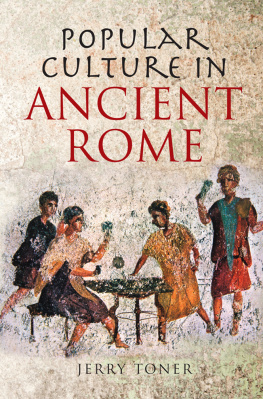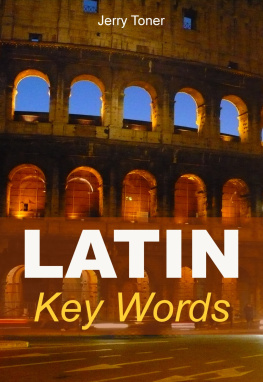Roman Disasters
Copyright Jerry Toner 2013
The right of Jerry Toner to be identified as Author of this Work has been asserted in accordance with the UK Copyright, Designs and Patents Act 1988.
First published in 2013 by Polity Press
Polity Press
65 Bridge Street
Cambridge CB2 1UR, UK
Polity Press
350 Main Street
Malden, MA 02148, USA
All rights reserved. Except for the quotation of short passages for the purpose of criticism and review, no part of this publication may be reproduced, stored in a retrieval system, or transmitted, in any form or by any means, electronic, mechanical, photocopying, recording or otherwise, without the prior permission of the publisher.
ISBN-13: 978-0-7456-6549-8
A catalogue record for this book is available from the British Library.
The publisher has used its best endeavours to ensure that the URLs for external websites referred to in this book are correct and active at the time of going to press. However, the publisher has no responsibility for the websites and can make no guarantee that a site will remain live or that the content is or will remain appropriate.
Every effort has been made to trace all copyright holders, but if any have been inadvertently overlooked the publisher will be pleased to include any necessary credits in any subsequent reprint or edition.
For further information on Polity, visit our website: www.politybooks.com
Images
View of Vesuvius erupting at night in 1944
Peter Ustinov as Nero in Quo Vadis (1951) playing his lyre as Rome burns
Mosaic showing the capture of a rhinoceros to be used in the games
Tombstone of a teacher and two of his pupils who died in an earthquake
Skeletons of victims in Herculaneum who had probably gone to the shore to try to escape by sea
Relief of a funeral procession
Terracotta relief from Ostia of a man milling grain
The household shrine from the house of Caecilius in Pompeii
Mosaic of an astronomer
Wall-painting from a Christian catacomb
Wall-painting of a merchant ship
Stone shop sign from a gambling house with four phalli and a dice cup
Votive offering
Relief of people carrying a menorah
Detail from the column of Marcus Aurelius showing the decapitation of barbarian prisoners
Dacian women torturing captured Roman soldiers in a scene from Trajans column
The family of Obellius Firmus, who died in Pompeii after the eruption of Vesuvius
Simeon the Stylite, shown here resisting temptation on top of the column where he lived
Tables
1 Natural disaster type ranked by number of deaths, 19471980
2 Hazard type by percentage of deaths, 19001999
3 Frequency and impact of earthquakes by continent, 19002010
4 Frequency and impact of epidemics by continent, 19002010
5 Frequency and impact of droughts by continent, 19002010
Acknowledgements
The aim of this book is to provide a broad and innovative treatment of the subject of disasters in ancient Rome. It tries to show the practicality and flexibility of the Roman political and cultural system in a way that is easily accessible to as wide a readership as possible, without sacrificing conceptual or empirical rigour. I came to the subject while researching into the non-elite in Roman society. It became clear that disasters, whether real, threatened or imagined, loomed large in the life of the average Roman. The effort involved in producing a book always means that many debts are incurred along the way. It is a pleasure to thank the following people, for all their support and encouragement: Pierre Caquet, Jason Goddard, Jon Gifford, William Harris, Peter Harvey, Chris Kelly, Bruce Kiddy, Justin Meggitt, Miranda Perry and Emma Widdis. My wife, Anne, contributed enormously to the project by acting as a sounding board for ideas and putting up with my many moods and absences while working on it. My son, Arthur, was born during the writing of this book and has taught me more than I would care to know about a whole range of issues. I am grateful to the President and Fellows of Hughes Hall, Cambridge, for their generous award of a Research Fellowship, and to the colleges mature undergraduates for providing so much interesting and thought-provoking discussion. I also want to thank the staff of the Cambridge University Library and Classics Faculty who have always been exceptionally helpful. Andrea Drugan and Polity did their usual excellent job in producing the book. The anonymous readers for Polity provided many astute comments and helpful criticisms. Above all, I want to thank Peter Garnsey, who has been a teacher and a friend for many years, who made many improvements to the manuscript, and to whom this book is dedicated as a token of gratitude.
What is a Disaster?
Anthemius trick shows us the degree of fear and panic that the experience of a disaster could generate within a Roman. This is hardly surprising given the unexpected nature and often devastating effects of natural disasters such as earthquakes. The onset of life-threatening events drives inhabitants of all societies into a state of confusion and alarm. But if we look a little deeper we can see that the story also reveals a number of characteristically Roman features. The first is that even for a wealthy orator like Zeno, building quality was of such a low level that even a modest wobble sent shivers of terror running down his spine. When we look at great Roman buildings, like the Colosseum or the Pont du Gard, it is easy to imagine that Roman building techniques were generally of a high standard. This is far from the case. Domestic architecture was, by modern western standards, often jerry-built: lacking adequate foundations and constructed of variable-quality materials. These were buildings which were prone to collapse even in normal conditions let alone when placed under the enormous stresses of an earthquake. The degree of panic which a wealthy man like Zeno showed, therefore, was partly an inverse index of his faith in Roman architectural practice. The fact that his neighbour was an engineer and architect seems to have done nothing to raise his level of trust in the ability of the building which they shared to withstand the impact of an earthquake. That Anthemius understood the mechanics of steam power but harnessed it only for the purposes of playing a practical joke on his neighbour underlines how different were the concerns of Roman engineers. The fake disaster, therefore, can be said to have stress-tested Roman life, thereby revealing both the limits of the social system and the faith that its inhabitants had in it. When we look at genuine Roman disasters, I suggest, we will be able to learn much about the wider Roman world and the expectations of its inhabitants.
Anthemius story also shows how disasters penetrated right to the top of Roman society. The wealthy could be just as vulnerable to events such as earthquakes and, what is more, the impact was something which Zeno assumed would be of interest to everyone in the palace. Indeed, the strong reaction of palace officials to what they saw as Zenos poor judgement in spreading false rumours of disaster shows how seriously they took such events. Obviously this interest stemmed partly from the fact that earthquakes affected everyone. Zeno would have been keen to see if his friends and colleagues had survived, or indeed if his enemies and competitors had been obliterated. But the emperors interest in the earthquake also reflected several other characteristically Roman concerns. Earthquakes destroyed buildings and if there was one thing which emperors were concerned about, it was their architectural legacy. It mattered to them if their pet building projects had been knocked down. On the other hand, the laying waste of a city might have its positive side. Disasters could generate significant opportunities for vast rebuilding programmes. The 64 CE Great Fire in Rome provided the emperor Nero with a rare chance to redevelop swathes of central Rome, one which he took full advantage of by building his infamous Golden Palace. It was hardly surprising that many Romans wondered whether Nero himself had in fact started the fire, so great was the personal benefit he accrued from it.



















